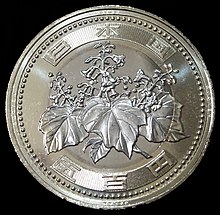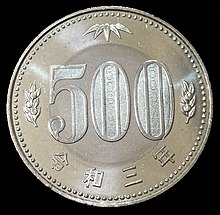| Value | 500 Japanese yen |
|---|---|
| Mass | 7.1 g |
| Diameter | 26.5 mm |
| Thickness | 1.81 mm |
| Edge | Reeded |
| Composition | Bi-metallic 75% Cu 12.5% Zn 12.5% Ni |
| Years of minting | 1982–present |
| Catalog number | Y-87, Y-99.2, Y-125[1] |
| Obverse | |
 | |
| Design | Paulownia |
| Design date | 2021 |
| Reverse | |
 | |
| Design | Denomination with Bamboo and tachibana |
| Design date | 2021 |
The 500 yen coin (Japanese: 五百円硬貨, Hepburn: Gohyaku-en kōka) is the largest denomination of Japanese yen coin issued for circulation. These coins were first struck in 1982 as the vending machine industry needed a higher valued coin for use in their machines. The denomination had previously been issued as paper currency which co-circulated with the new coins until 1994. Originally the 500 yen coin was made up of cupronickel, but was later changed to nickel brass, and then to bi-metallic to deter counterfeiting. This illegal practice has been a constant issue since the coin was first released due to its high purchase value. With a history spanning 3 imperial eras, 500 yen coins are also collectibles.
- ^ "Japan 500 Yen". Numismatic Guaranty Corporation. Archived from the original on August 12, 2023. Retrieved October 17, 2020.